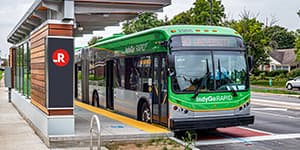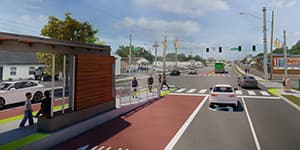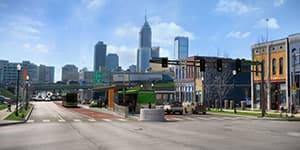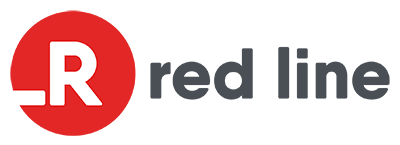“We’re doing our part so you can relax and breathe easy. Easy, Breezy, Cleaner Air with Lumin-Air.”
IndyGo and Lumin-Air UV-C Light Filtration System
IndyGo has officially launched the Lumin-Air state-of-the-art UV-C light air filtration system on its entire fleet of buses in service, including paratransit, regular fixed route and Red Line buses. This system helps continuously remove pathogens, allergens and some odors from the air riders breathe, bringing them “Easy, Breezy, Cleaner Air with Lumin-Air.” IndyGo is now the first transit agency in the nation to install this system on its full fleet.
In the wake of the lifting of the federal transportation mask mandate, passengers will now have peace of mind and an additional layer of protection while traveling on IndyGo buses. This is the agency’s latest effort to increase rider and bus operator safety from threats such as COVID-19, along with other viruses and contaminants in the air.
“I’m proud to say our buses now have some of the cleanest air in the country,” said IndyGo President and CEO Inez Evans. “With the installation of this system, we’re demonstrating how we prioritize safety. Our riders and coach operators can breathe easier knowing their air is cleaner than ever before when they travel with us.”
The system leverages the HVAC unit on buses to draw in air from the bus compartment, filter it, eliminate harmful contaminants and return the clean, conditioned air back to the bus. The system is completely self-contained, meaning riders are not exposed to UV-C light and nothing is emitted into the air people breathe. The entire volume of air in a bus passes through the HVAC system once every two minutes, compared to once every six to 10 minutes in an office space. This level of circulation helps ensure the continuous replenishment of clean air inside the bus.
Learn more about Lumin-Air and their other projects here.
What does cleaner air on the bus mean to our riders and coach operators?
FAQs
SARS-CoV-2 (the virus that causes COVID-19) and other respiratory pathogens are primarily spread via airborne transmission. This happens when a person breathes in infected particles and aerosols that contain the pathogen. This system helps continuously reduce the concentration of those particles and aerosols in the air. While we will continue to be vigilant in cleaning and disinfecting surfaces, we value the effectiveness of creating a layered approach. Investing in systems to remove particulates and aerosols from recirculated air is critical to the health and safety of our riders and operators and follows recommendations from the Centers for Disease Control and Prevention (CDC) and American Society of Heating, Refrigerating, and Air Conditioning Engineers (ASHRAE).
IndyGo, through a partnership with Lumin-Air, installed a MERV 13 equivalent filter and ultraviolet light (UV-C) system to help continuously filter and clean recirculated air inside our vehicles. Increasing filtration efficiency and using UV-C are recommended strategies to help prevent the transmission of airborne pathogens and to improve indoor air quality as outlined by the Centers for Disease Control and Prevention (CDC) and American Society of Heating, Refrigerating, and Air Conditioning Engineers (ASHRAE).
The system leverages the HVAC system on our buses to draw in air from the bus compartment, filter it, and return cleaned, conditioned air back to the space. The system is completely self contained. This means riders are not exposed to UV-C light and nothing is emitted into the air people breathe. Whenever the bus is on the system is in operation. The system will always be in operation while riders are on the bus. The entire volume of air in a bus passes through the HVAC system once every two minutes compared to once every six to 10 minutes in an office space. This level of circulation through the system helps ensure the continuous replenishment of cleaned air inside the bus.
This system is one of the first of its kind to use both high-efficiency filtration and UV-C to improve indoor air quality in a transit environment. By leveraging the existing HVAC system on the bus, this filtration and UV-C light system produces one of the highest clean air delivery rates (CADR). The entire volume of air in a bus passes through the HVAC system once every two minutes compared to once every six to 10 minutes in an office space. This level of circulation through the system helps ensure the continuous replenishment of cleaned air inside the bus.
The installed system does NOT shine UV-C light inside the occupied bus compartment, on occupants or on materials. The installed UV-C system does NOT produce ozone or other secondary contaminants. UV-C is only applied to air passing through the bus’s HVAC system. The system is equipped with a safety door disconnect to prevent power to the system in the event the access door is opened.



